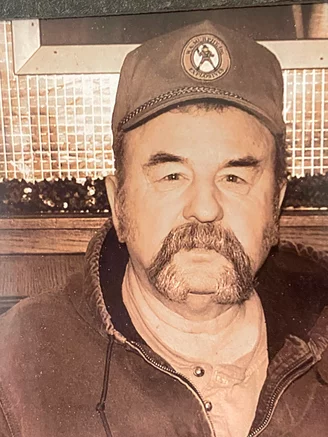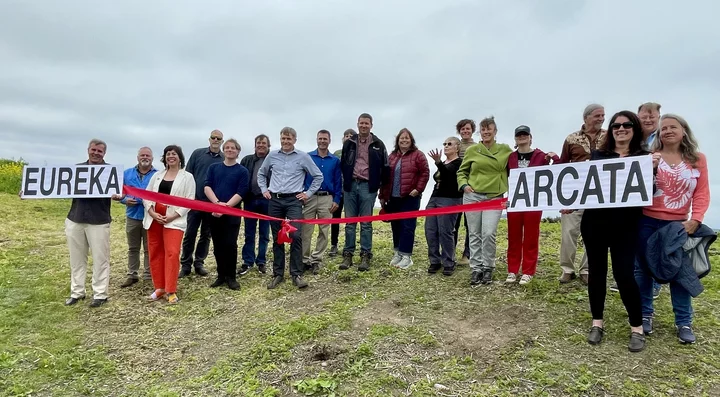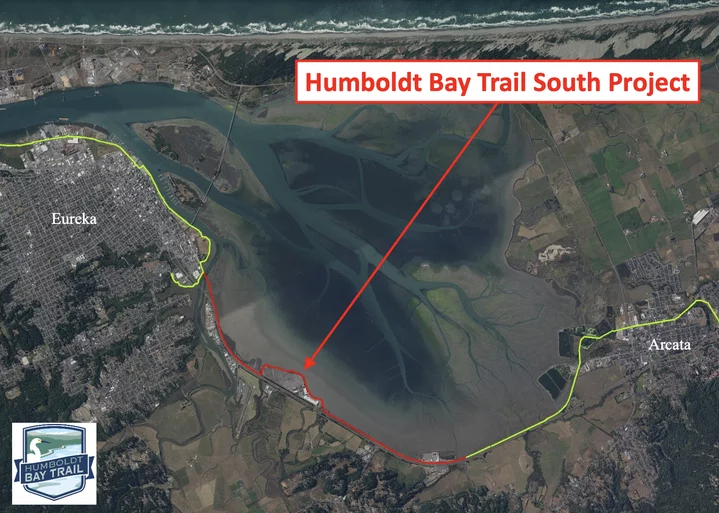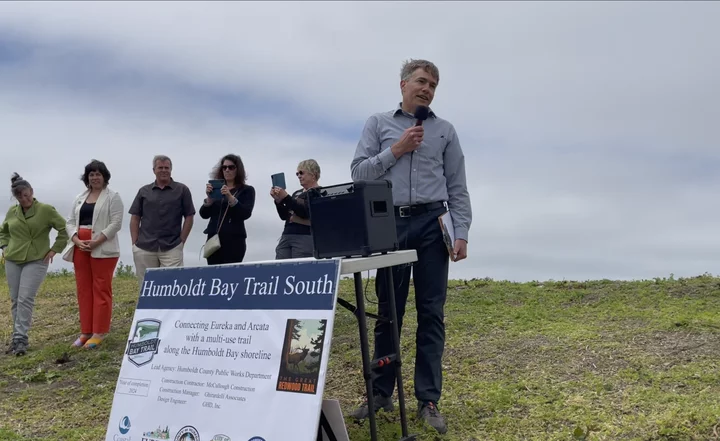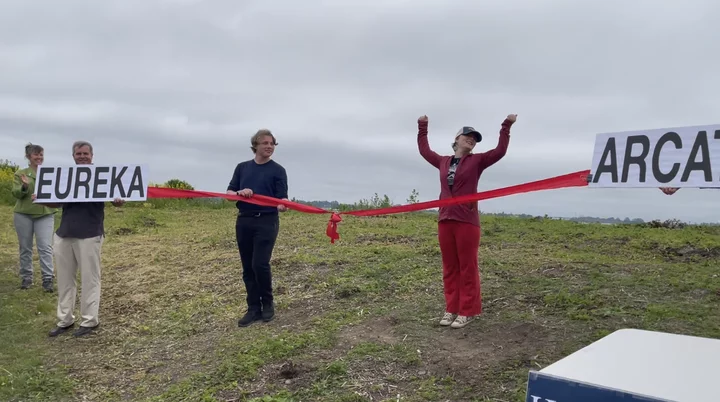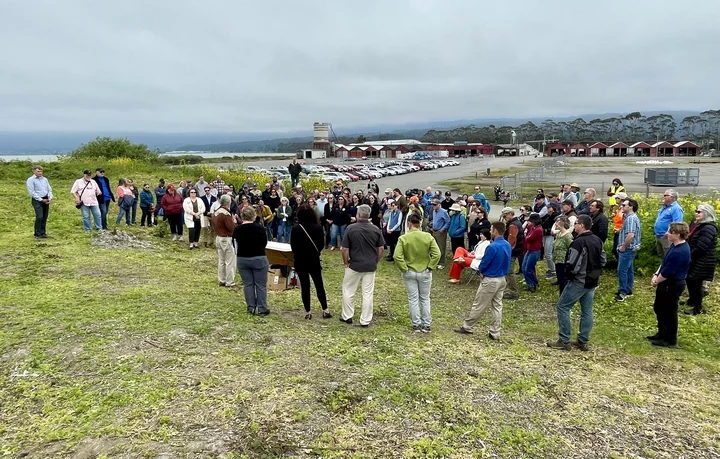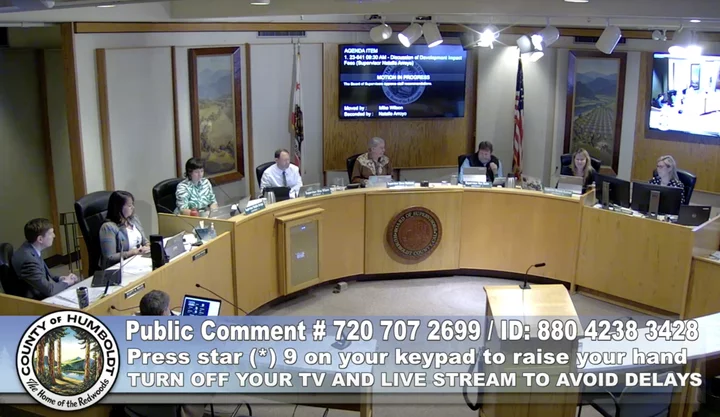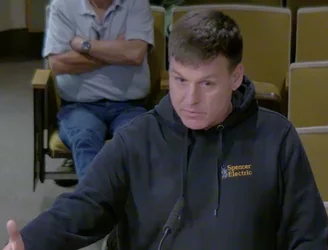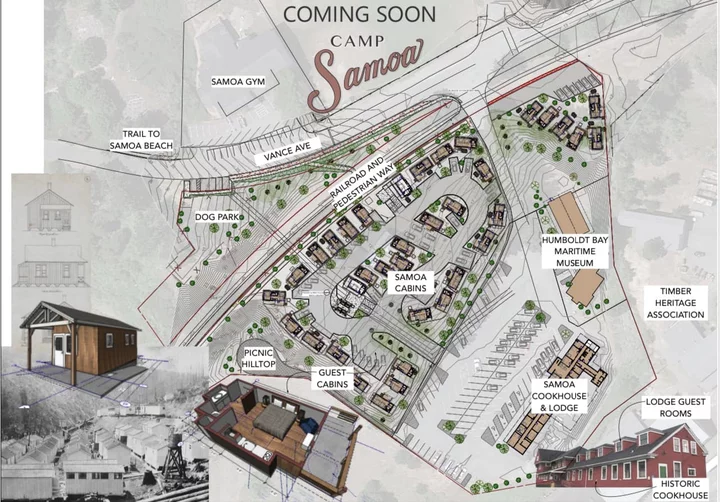OBITUARY: Richard Roy Rollins, 1965-2023
LoCO Staff / Thursday, May 18, 2023 @ 6:56 a.m. / Obits
Richard Roy Rollins passed away in his home on April 27, 2023 after a
hard-fought battle with pancreatic cancer. Rick was a
sixth-generation Humboldt County resident born February 14, 1965 in
Garberville. He was related to early settlers of the Mattole Valley
and surrounding areas.
Rick attended school in Fortuna and attained his GED in 1981. He met his wife, Kim, in 1987 and they later married in 1992. Together they had two children, Levi and Taylor, whom they raised in Honeydew until later buying a home in Carlotta in 2002.
Rick worked many jobs until he found his passion being a farm manager and master grower in the cannabis industry. This career later took him and his wife Kim on an adventure to Oklahoma for 13 months. He was a hard worker who rarely took a day off, even through chemotherapy and other health issues. Rick loved hunting, fishing, mounting biking, going to sporting events and spending time with family and friends at the beach cabin.
Rick is preceded in death by his father, Hollis Rollins Jr; grandparents Paul and Anne Smith, and Hollis and Mod Rollins; uncles Larry Smith and Bud Rollins.
Rick is survived by his wife, Kim Rollins; children, Levi Rollins and Taylor Rollins; mother, Jeanne Rollins; sister and brother-in-law Cindy Carter and Frank Carter; aunt and uncle Linda and Bill Franklin; and numerous step-siblings, half-siblings, nieces, nephews and cousins.
A celebration of life is to be held on June 24, 2023 at 12 p.m. at the Mattole Grange: 36512 Mattole Rd, Petrolia. All family and friends are invited and welcome. This will be a potluck-style event and we would ask attendees to please bring a side dish or dessert if able.
###
The obituary above was submitted on behalf of Rick Rollins’ loved ones. The Lost Coast Outpost runs obituaries of Humboldt County residents at no charge. See guidelines here. Email news@lostcoastoutpost.com.
BOOKED
Today: 12 felonies, 20 misdemeanors, 0 infractions
JUDGED
Humboldt County Superior Court Calendar: Friday, Jan. 9
CHP REPORTS
Sr3 / Deerlick Springs Rd (RD office): Animal Hazard
ELSEWHERE
RHBB: Power Out to Customers Near Ferndale May Be Connected to Traffic Collision
RHBB: Army Chinook Helicopter Draws Attention During Flight Over North Coast
The Guardian: ‘The last actual hippie’: musicians pay tribute to the Grateful Dead’s Bob Weir
The Guardian: Kristi Noem vows to send ‘hundreds’ more agents to Minneapolis as protests erupt across US
OBITUARY: Daniel J. Flanagan, 1949-2023
LoCO Staff / Thursday, May 18, 2023 @ 6:56 a.m. / Obits
Daniel J. Flanagan
October 11, 1949 – May 13, 2023
Dan was born October 11, 1949 in Washington D.C. to Daniel J. Flanagan Jr. and Agnes Mae Briggs Flanagan. Dan’s early years were spent between Washington D.C and the family town of Erie, Penn. In August 1953, Dan moved with his family to San Mateo, Calif.
Dan graduated from Serra High School, Class of 1968. After graduation, Dan enlisted in the Air Force, serving four years. While in the service, he married his high school sweetheart, Margie Gantvoort.
Upon discharge from the Air Force, Dan gained employment with PG&E. He was employed with PG&E from March 5, 1963 until retirement November 1, 2014.
Dan was a member of the Redwood Gun Club, Simpson Gun Club (Long Prairie Gun and Archery Club) as well as a Board Member of the Humboldt Trap and Skeet Club.
Dan was an avid outdoorsman and loving father. He enjoyed hunting, fishing, and cutting firewood. He shared his love of the outdoors with his boys; together they made lifelong memories that will be forever cherished. Dan was a family man first and foremost. He lead by example in life; always putting family needs before his own wants and desires. He always made sure the family never did without. He built a strong work ethic in his sons and many of their friends throughout the years, something he was extremely proud of. The door was open to all who came as well as the kitchen: “One rule, don’t eat off my plate!”
Dan is survived his wife of 53 years, Margie; by his three sons, Brian (Amy), Michael (Kelli) and James. He is survived by 10 grandchildren: Lane, Tanner, Brenna, Noel, Jaron, Ace, Brilyn, Rilyn, Mathew and Henry. He is survived by two great-grandchildren: Jasper and Bella. Dan is also survived by his two sisters, Anne Pinkston and Kathleen Benker, and numerous nieces and nephews.
The family would like to thank the following people for walking by Dan’s side through his difficult battle with cancer: Dan’s friends, Dr. Iberri and assistant Kate at Stanford Medical Center, and the entire staff at Providence Health Chemo Infusion Suite. We would like to extend a special thank you to his nurses – Barbara, Ivy, Jade, Jovone – the ones who “drew the short straw.”
Dan was interred at Ocean View Cemetery. A celebration of life will be held at a later date.
###
The obituary above was submitted on behalf of Daniel Flanagan’s loved ones. The Lost Coast Outpost runs obituaries of Humboldt County residents at no charge. See guidelines here. Email news@lostcoastoutpost.com.
Groundbreaking Ceremony Celebrates Start of Construction on Humboldt Bay Trail South, Which Will Finally Connect Eureka and Arcata
Ryan Burns / Wednesday, May 17, 2023 @ 4:52 p.m. / Trails
Eureka City Manager Miles Slattery and Arcata City Manager Karen Diemer (holding signs for their respective cities) celebrate the groundbreaking of Humboldt Bay Trail South with a “ribbon-tying” ceremony, accompanied by a range of stakeholders including state and local officials, community volunteers, businesspeople and others. | Photos by Ryan Burns.
###
After decades of dreaming, planning and lots of work to overcome bureaucratic hurdles, Humboldt County will soon have a paved multi-use trail connecting Eureka and Arcata along the banks of Humboldt Bay.
At a joyous ceremony this afternoon, held atop a berm overlooking the bay from the California Redwood Company sawmill property, state and local officials gathered with community members and other stakeholders to celebrate the start of construction on Humboldt Bay Trail South, a project that will connect the gap between the Eureka Waterfront Trail and the southern terminus of Humboldt Bay Trail North, near the Bracut Industrial Park.
Map of the Humboldt Bay Trail courtesy the County of Humboldt.
###
Leading off the ceremony was Hank Seemann, Humboldt County’s deputy director of public works, who everyone in attendance seemed to agree has been one of the primary driving forces behind the project.
“It has been a long journey to get to this point,” Seemann said, triggering a round of knowing laughter from the assembled crowd.
After noting that everyone was standing on un-ceded Wiyot territory, he went on to note that, until about 25 years ago, most of the shoreline development between Eureka and Arcata was dedicated almost exclusively to cars, the railroad and private industry. But the community had a vision to restore public access to the shoreline while connecting people with each other and the natural world.
That vision has largely come to fruition, Seemann said, thanks to work from employees and officials at the City of Arcata, the City of Eureka and, lately, the County of Humboldt, not to mention “vital support from our community and state partners.”
Hank Seemann addresses the crowd.
###
Construction of the trail is set to begin next month and be completed before the end of 2024. The main contractor is Arcata-based McCullough Construction. Ghirardelli Associates, which has its headquarters in San Jose and an office in McKinleyville, will provide construction management services while international engineering firm GHD, Inc., will provide engineering support.
The cost of construction on this section of trail alone will amount to nearly $20 million, according to Brandon Larson, deputy director for planning and local assistance with Caltrans. Funding has been provided by the California Transportation Commission, the State Coastal Conservancy and Caltrans District 1.
The majority of this new trail segment will be situated between the defunct railroad and Highway 101, while a one-mile portion will be placed atop the levee around the bay side of the Brainard Mill site. This route was made possible thanks to an easement from Green Diamond Resource Company to the county.
Construction will involve widening the railroad prism, major modifications to the Eureka Slough railroad bridge, construction of three new trail bridges and removal of the northernmost stretch of eucalyptus trees along the highway. The project will also entail what the county calls “urgent repairs” to erosion damage along the railroad as well as raising the elevation of the railroad between Brainard and Bracut to address flood hazards.
Fourth District Humboldt County Supervisor Natalie Arroyo speaks into the microphone.
###
“I have to say, being here today, my face hurts from smiling,” said Humboldt County’s Fourth District supervisor, Natalie Arroyo. “This is such an exciting moment.”
She said that, looking around the crowd, she recognized “the faces of so many people who have been essential to making this happen,” including folks she worked with on the Humboldt Trails Council and the Redwood Community Action Agency (RCAA).
“And now here we are today about to build this trail, and I could not be more thrilled,” Arroyo said.
Fifth District Humboldt County Supervisor Steve Madrone, who also serves as the vice-chair of the Great Redwood Trail Agency, said it has been 37 years since RCAA, the County of Humboldt and the state Coastal Conservancy formed a partnership to start looking at trails in this region.
“And it was in 1997 that our first report on possible trail options around the bay was put together,” Madrone said.
First District Supervisor Rex Bohn recalled riding his Schwinn bicycle from Eureka to Arcata to meet up with a girlfriend some 55 years ago. He rode home along Old Arcata Road and said he looks forward to a better route. Bohn also thanked state Senator Mike McGuire and Assemblymember Jim Wood for being “so instrumental” in getting trails built.
Jason Liles, McGurie’s chief of staff, was on hand. He noted that his boss was attending a wind energy hearing in Sacramento and thus, regrettably, could not attend the trail groundbreaking ceremony. He went on to say that in his office there’s a rule that you should only thank elected officials because they get their feelings hurt if you don’t. But in this case, he made an exception.
“I’m just gonna thank one person in particular on behalf of Senator McGuire, and I’d like to see a big round of applause for Hank Seemann,” Liles said, and the crowd complied with enthusiasm.
Caryl Hart, chair of the Great Redwood Trail Agency, emphasized the economic benefits of trails, and she noted that this trail will eventually be part of her agency’s namesake, a planned 320-mile multi-use rail-to-trail project connecting San Francisco and Humboldt bays.
“One of the things that I hear most often is, ‘Will [the Great Redwood Trail] happen in my lifetime?’” Hart said. “I’m so glad that I can say, ‘Go to Humboldt Bay. You will see the Great Redwood Trail as it is being created, as it is connecting around the bay … and that is thanks to all of you.”
Several other folks addressed the assembled crowd. Arcata City Manager Karen Diemer, for example, said, “This is what government looks like when it is following the deep will of your people.”
Eureka City Manager Miles Slattery also commended the broad community collaboration and cracked a joke: “I can’t believe I’m saying this, but I can’t wait for Eureka to be hooked up to Arcata,” Slattery said, getting a big laugh.
Karen Underwood, a board member with the Humboldt Trails Council, said research indicates that when trail gaps between two cities get connected, use of the trails can increase from 40 to 80 percent, but this connection will likely be an outlier.
“After 25 years of waiting Humboldt Trails Council believes that usage of these bay trails will more than double,” Underwood said.
At the conclusion of the ceremony there was a ribbon tying — rather than the traditional ribbon cutting — to emphasize the upcoming new connection between Arcata and Eureka.
Youngsters Asher Bergel (son of Eureka Mayor Kim Bergell) and Nigella Bauer (daughter of Third District Humboldt County Supervisor Mike McGuire Wilson), who was in Washington, D.C.) did the honors, hooking the two ends of the ribbon together, but only after noting that the project has been in the works since before they were born.
HUMBOLDT TODAY with John Kennedy O’Connor | May 17, 2023
LoCO Staff / Wednesday, May 17, 2023 @ 4:29 p.m. / Humboldt Today
Today’s newscast! Press play above, read below, take the poll even further below.
FURTHER READING:
- Samoa Cookhouse Closes Temporarily for Major Renovation to Create Hostel Rentals, Cabins, Dog Park and Picnic Area
- Anticipating Big Economic Growth, Board of Supervisors Explores the Idea of Impact Fees for New Development. Plus: Preserving Public Access, and More
- Kamome Foundation Delegation to Celebrate Mural’s Arrival in Rikuzentakata
- With ‘Chalk Talk,’ an Unknown Author Addresses Eureka’s Homelessness Issues One Word at a Time
HUMBOLDT TODAY can be viewed on LoCO’s homepage each night starting at 6 p.m.
Anticipating Big Economic Growth, Board of Supervisors Explores the Idea of Impact Fees for New Development. Plus: Preserving Public Access, and More
Isabella Vanderheiden / Wednesday, May 17, 2023 @ 12:46 p.m. / Local Government , Offshore Wind
Screenshot of Tuesday’s Humboldt County Board of Supervisors meeting.
###
As several major projects move steadily ahead throughout the Humboldt Bay region, county officials are looking for ways to offset potential impacts associated with future development. The Humboldt County Board of Supervisors, prompted by Fourth District Supervisor Natalie Arroyo, revisited the topic of development impact fees during Tuesday’s meeting as a strategy to better accommodate incoming residents.
In a nutshell, development impact fees are fees that are imposed on specific projects to mitigate costs associated with new or additional public facilities – including fire and public safety, parks and transportation – that are needed to serve those developments. They must be based on the impact of new development and the cost of providing additional facilities or improvements.
Humboldt County is the only county in California that does not have development impact fees, largely due to the county’s historically low growth rate, but that may be about to change.
Cal Poly Humboldt is rapidly expanding to accommodate its increasing student population. Nordic Aquafarms is furthering its plans to build a land-based fish farm on the Samoa Peninsula. Crowley Wind Services is working with the Harbor District to build a full-service terminal on Humboldt Bay to support a 200-square-mile offshore wind development off the North Coast. There are also a couple of high-speed fiber optic lines being built in the region that will feed into a big data center in Arcata. And then, of course, there will be all the new housing that will be needed to support these big projects.
As developments move forward, the county and local municipalities can expect even more pressure on existing public resources and facilities. That’s where development impact fees come in.
Planning and Building Director John Ford noted that, while the county doesn’t have a development impact fee program per se, the costs are applied and accounted for throughout the development process. Ford used the North McKay Ranch Subdivision as an example.
“In that particular case, the [Environmental Impact Report] EIR identified that there were traffic impacts that needed to be addressed,” he explained. “The way a traffic fee would work – as applied to that [project] – is that the county would have done a nexus study to identify what the cumulative impacts are needed to implement the development allowed by the General Plan, and … identify a list of improvements that are needed to address those impacts and then to identify fees associated to implement them in that particular case.”
While development impact fees tend to add to the cost of a building permit, Ford noted that developers would be able to calculate their costs up front instead of going through the EIR process “to understand what their fees are.”
Second District Supervisor Michelle Bushnell asked how development impact fees would affect rural, unincorporated communities. Ford said it would depend on the community and the improvements needed to mitigate the impacts of a specific development.
“The downside, frankly, is that when your growth rate is slow and the amount of money coming in from fees isn’t sufficient to fund the improvements … the money gets returned [to the developer],” he said. “It’s really not applied very much in the rural areas. We just don’t see that kind of growth that the more populous counties do where they’ll build a new town in the middle of nowhere with 10,000 people. That’s not the kind of growth that we see.”
First District Supervisor Rex Bohn said he had contacted a few local housing developers ahead of Tuesday’s meeting and said they were “very concerned” about the prospect of the county implementing development impact fees.
“I’m not saying this is a bad idea [or] something that shouldn’t be looked at … but do we reach out enough and talk to the people that are actually going to be affected?” he asked. “The people that are going to be here tomorrow … to build houses into the future because we’re losing those. … I don’t think it’s great idea, but I’m not against it.”
Bohn recommended county staff look into the item further before moving forward. Fifth District Supervisor and Board Chair Steve Madrone noted that the item did not require any immediate action from the board, adding that staff’s recommendation would direct staff to conduct more research on the subject and bring a recommendation back to the board with a scope of work and cost estimate.
Third District Supervisor Mike Wilson said he would support a continuance of the discussion but also expressed his support for the implementation of development impact fees, noting that “it’s not just about the up front cost.”
“It is about the sort of the pain of paying up front for infrastructure and services, but we also have to remember all the folks that live in the community that … will use and utilize – and require, really – the services and infrastructure associated with fees like this,” he said. “We’re lacking in that space. I would also add that recreational districts are really popular and have been for a long time. There have been fees around that because they bring needed and really very popular infrastructure to communities and neighborhoods that are actually valuable to people’s property values and public safety.”
Returning to Bohn’s previous comment, Arroyo noted that she completely agreed that extensive outreach would be essential to implementing a development impact fee program but said, “I view this very much as a slow burn item.”
“I see this as something … that could would take quite a while to implement because there would need to be a lot of underlying study and analysis,” she said. “We would need to really understand to what type of development this applies and what kinds of improvements we’d be seeking to fund with the development impact fees. … It would be good to confer with our counterparts in the cities to understand what their appetite is for this and … [if there are] potentially other community services that can be funded.”
Returning to the subject of increased building costs, Bushnell said she would like to know more about how development impact fees would affect rural communities in comparison to cities, but said she wouldn’t be in favor of an additional fee that would serve “as a deterrent to building homes.”
Bushnell also asked Ford how the additional research would impact staffing in his department. “A lot of it depends on the board’s action on the budget in terms of what our staffing is gonna look like,” he said.
Speaking during public comment, Dave Watson, a representative of the Humboldt Builders Exchange, said he generally agreed with Bohn’s concerns surrounding increasing building costs but expressed support for Arroyo’s idea of streamlining the process to make it easier for development along the way.
“That’s absolutely fantastic, but I think the real fear is that it’s going to end up costing more money,” he said. “We’ll establish a secondary bureaucracy. We’re going to add more steps and the [EIRs] and all the other mitigation are still going to need to happen. It’s hard to see this as a net positive but I’m absolutely going to participate in any way that we can.”
After a bit of additional discussion, Wilson made a motion to move forward with staff’s recommendation to conduct more research on the item. The motion passed in a 4-1 vote, with Bushnell dissenting.
Public River Access at Fisher Road
The Board of Supervisors also received an informational report from staff regarding public access to the Van Duzen River via Fisher Road near Hydesville.
Local residents and avid fishermen have used Fisher Road to access the Van Duzen River for decades, but a change in the river’s course a few years back left a near-vertical cliff along the bank, making river access more difficult. The river access point also requires trespassing on private property, though the county has asserted a common-law dedication through public use and maintenance.
The property owners, Kelly and Shelby Patton, asked the county to give up the southern portion of the road late last year to prevent the public from using it as a river access point. The matter was listed on the board’s Dec. 20 agenda but the meeting was canceled in response to the magnitude 6.4 earthquake that rocked the entire county.
Members of the Humboldt County Fish and Game Advisory Commission have pushed back against the property owners’ request to vacate the road, arguing that the public has a right to access the Van Duzen River.
“California’s Constitution of 1879, laws, and judicial decisions have established public rights to access the state’s navigable waters, as well as tidelands, submerged lands, streams, lake, bays, and estuaries,” according to an Apr. 18 letter from the commission. “These resources are held in ‘public trust’ for current ad future generations. The public trust doctrine was established to ensure that government officials protect these sovereign lands for the use and enjoyment of the public, free from the obstruction of interference of private landowners.”
Before taking questions from supervisors, a lawyer from the county counsel’s office advised board members to keep their questions focused on public access rather than Fisher Road specifically. Similarly, Madrone reminded the board several times throughout the discussion that the item at hand was an informational report and did not require any additional direction from the board.
Speaking during public comment, Alicia Hamann, representing Friends of the Eel River and the Great Redwood Trail Coalition, advocated for continued public access to the river.
“You’ve heard from many community members who value this relatively rare point of access on the Van Duzen River and many of those people also have used this road to access the river for decades,” Hamann said. “I want to focus right now on reminding the board that about 30 years ago, the supervisors proudly protected public river access, even going as far as litigating to preserve public access at Odd Fellows Park Road, about a mile east of Fisher Road, as referenced in our letter.”
Hamman added that the court’s ruling established that the Van Duzen was a navigable waterway, adding that the public had a right to use the river and the riverbed up to the high watermark.
Speaking on behalf of the Humboldt Trails Council, Bruce Silvey emphasized the importance of the county securing and maintaining public access to Fisher Road, which will eventually intersect with the proposed Great Redwood Trail.
“The river access, at this point, is the only access along the Carlotta Branch Trail and the trails council believes that having a clear river access point will have an important impact on the number of people using the trail,” Silvey said. “The more people who use the trail, the safer the users feel and the less unwanted activities will occur on the trail. Also, there’s added benefit of a healthier and happier community with increased trail use in the county.”
Steve Rosenburg, a retired attorney and a fisherman, added that the public has a right to use the river access point under the California Constitution and case law.
“The end of [Fisher] Road has been used – until a few years ago – for over 75 years continuously despite the fact it’s been in private property ownership in the last several years,” he said. “The public has a permanent right, by this long-established use, to not only require the county to continue the county road in effect [but] also, the public has a right to use the private property’s narrow strip of land for access to the river bar as it has for 75 years.”
Rosenburg acknowledged the issue of dumping and illegal camping on the river bar but maintained that “there’s a way to handle that through enforcement, key access,” and other strategies.
Kelly Patton, one of the property owners, maintained that “there is no deeded right-of-way all the way down Fisher Road,” adding that he had former Second District Supervisor Estelle Fennell and a representative with Fish and Wildlife at his property some years ago to look at the road.
“They pulled all the armor out of the bank that had been there 35-plus years and protected that parking lot,” he said. “Basically, we argued about [the] process of what them pulling the armor out was going to do to the access. They told me I was a fool and said I didn’t know what I was talking about. The first winter, about five years ago, it washes all out and gets blocked off. And not by our doing. I did everything I could to keep it open. But we’re not going to give up more land or give up part of our fields to give new access to the county.”
Patton added that there are several other river access points in the area.
His wife, Shelby, criticized the Fish and Game Advisory Commission and others for “being outraged about things they don’t know” and for failing to consider the other side of the story.
“If people don’t choose to find out what the truth is and what property law is, we’re going to continue to repeat and repeat these issues,” she said. “I can definitely tell you, in this particular case, if [the Fish and Game Advisory Commission or Rosenburg] had just approached us personally [and] respectfully, we might not be in the same situation we’re in right now.”
Turning back to the board for discussion, Wilson acknowledged the “variety of opinions around public access,” but said that the county, as a public trust agency, is obligated to “public trust responsibilities with relation to access to public trust resources throughout the county.”
Wilson made a motion to receive and file the report, which was seconded by Arroyo. The motion passed 5-0.
###
Other notable bits from Tuesday’s meeting:
- The County Administrative Office requested the board pull an item from the consent calendar to further discuss a $4.5 million bid to repave the parking lot at the California Redwood Coast-Humboldt County Airport. To meet requirements set by the Federal Aviation Administration (FAA), the county is required to open the public bidding process before receiving the FAA grant funding. The winning bidder will be selected shortly after bids open on May 31, and a separate item will be brought to the board to enter into a contract with the winning bidder. The county will be reimbursed in full for costs associated with the project.
- The board met in closed session to discuss anticipated litigation from former Deputy County Counsel Cathie Childs who asserts that she was wrongfully terminated by the county last fall. The CAO did not report any action on the matter.
- The board adjourned in memory of local artist and activist Richard Evans, who passed away earlier this year.
Samoa Cookhouse Closes Temporarily for Major Renovation to Create Hostel Rentals, Cabins, Dog Park and Picnic Area
LoCO Staff / Wednesday, May 17, 2023 @ 10:29 a.m. / News
Plans for the renovated Samoa Cookhouse grounds. | Click here for larger image.
###
Press release issued by Danco on behalf of the Samoa Cookhouse:
We are thrilled to announce the upcoming renovation of one of the most historic and last-standing Cookhouse restaurants in the Western United States. We are confident that this renovation will enhance the experience for our guests and ensure that the Samoa Cookhouse continues to be a beloved destination for years to come.
Since 1890, the Samoa Cookhouse has long been known for its distinctive character, and we are committed to preserving that character while also making necessary updates to ensure that the space is comfortable, functional, and welcoming for all guests.
The renovation will be a significant undertaking, with a focus on preserving the restaurant’s historic character while also updating the space to meet the needs of modern restaurants.
Major improvements will involve adding eighteen rentable hostel rooms upstairs and one fully accessible ADA unit on the main floor, outdoor seating areas, and adding thirty-six cabins below the Samoa Cookhouse which can be rented for family gatherings and events.
We are aware that the renovation of the Samoa Cookhouse means you will have to wait to eat our famous french toast and delicious fried chicken, but we know you will understand that this renovation is necessary to improve and provide you with an even better dining experience in the future.
Thank you for your continued support and enthusiasm for this project. We appreciate your patience and loyalty, and we look forward to welcoming you back once the renovation is complete.
The Samoa Cookhouse
California Has Tried to Cut the Cost of Insulin for Years. Why It Might Finally Succeed
Kristen Hwang / Wednesday, May 17, 2023 @ 7:53 a.m. / Sacramento
Photo by Mykenzie Johnson on Unsplash.
The high cost of insulin has been a niggling thorn in the side of regulators and patients for decades: Prices for the 100-year-old drug have increased more than 600% in the past 20 years, and stories of patients rationing doses abound. Even the most conservative economists point to it as an example of a market gone sour.
Despite repeated efforts at the federal and state level to rein in the cost of pharmaceuticals, prices go up each year, growing quicker than any other health care service and routinely outpacing the rate of inflation.
This year, California is poised to do something different to cut the cost of insulin, attacking the problem on three fronts. And if it works for insulin prices, it could work for other drugs:
- Lawmakers have introduced a bevy of bills targeting out-of-pocket insulin costs. They have also advanced legislation ensuring cost savings for all drugs get passed down to patients;
- Attorney General Rob Bonta is suing the nation’s largest insulin manufacturers and pharmaceutical benefit managers for driving up the cost of the life-saving drug, alleging unfair business practices;
- And Gov. Gavin Newsom recently announced a $50 million state contract with generic drug company Civica Rx to manufacture three types of cheap biosimilar — or generic — insulin for diabetic Californians.
This three-pronged approach isn’t perfect — measures like the ones suggested by lawmakers this year have failed several times — but legislators are hopeful the resources of usual opponents will be divided among the state’s other efforts. Health economists and patient advocates believe the state’s lawsuit will lift the veil on opaque pricing tactics for the first time nationwide, potentially shifting how industry players behave.
“It’s good the state of California is using its power as a purchaser, a regulator (and) a litigator to try to address this issue,” said Anthony Wright, executive director of Health Access California, a consumer advocacy group that routinely sponsors health care affordability measures. “This is such a multi-faceted problem that it requires a lot of different solutions.”
Insulin: The poster child for a broken market
So who’s to blame for the skyrocketing cost of pharmaceutical drugs? Ask any number of industry players and you’ll get stuck in an endless loop of finger pointing. Manufacturers blame insurers and intermediaries known as pharmaceutical benefit managers for exploiting profit models. Those groups in turn blame manufacturers for setting high prices to begin with. In the end, the patient pays.
“There are no heroes in health care,” said Kevin Schulman, a professor of medicine and operations, information and technology at Stanford University. Schulman sits on the scientific advisory board for Civica Rx.
In California, between 2017 and 2021, state-regulated health plans increased spending on prescription drugs by more than 22%, or $2.1 billion, according to a recent price transparency report. By comparison, medical expenses increased 18.4% during the same time period. Prior to the COVID-19 pandemic, medical expenses had increased just 8.2% while drug spending increased 14.4%.
For many people with health insurance, increasing pharmaceutical prices are obscured because insurance picks up a majority of the tab. However, people who are uninsured or who have not hit their annual deductible pay the full drug price out-of-pocket.
The cost of insulin has become the consistent linchpin of these drug price discussions. Some people with diabetes — approximately 37 million in the United States and about 3 million in California — need insulin to regulate their blood sugar. Without it they will die.
“There are no heroes in health care.”
— Kevin Schulman, professor of medicine and operations, information and technology at Stanford University
Until very recently, the average list price of insulin increased about 11% annually, with some common brands exceeding $400 per vial. Actions by the federal government to impose out-of-pocket price caps and penalize manufacturers that raise prices faster than the rate of inflation spurred the three largest insulin manufacturers to drop prices to $35 earlier this year. However, during a U.S. Senate committee hearing last week, executives from Novo Nordisk and Sanofi would not commit to keeping prices that low.
“We’ve seen a little bit of a collapse these last few weeks…this will provide some relief, but at the end of the day the thing we don’t know is how (pharmaceutical benefit managers) are going to respond to these cuts,” Schulman, who researches the pharmaceutical market, said. “In theory, they have no interest in supporting these low-cost products.”
Why wouldn’t these intermediaries support low cost drugs? The answer lies in a complex and convoluted system of rebates that drug companies pay pharmaceutical benefit managers. Pharmaceutical benefit managers control the list of drugs that health insurance plans cover, also known as a formulary. Consolidation has resulted in three companies — CVS Caremark, Express Scripts and OptumRx — representing more than 80% of the market. To incentivize benefit managers and insurers to cover their products, manufacturers offer them a cut of the sale price, or a rebate.
The trade group representing pharmaceutical benefit managers claims more than 90% of these rebates, also known as discounts, are passed on to insurers to help lower the cost of health insurance premiums. But researchers say without regulation mandating transparency, it’s impossible to know who exactly keeps the rebates and how they’re used.
Erin Trish, an associate professor of pharmaceutical and health economics at the University of Southern California, said what results is a competitive market where prices for many drugs are driven higher rather than lower.
“It creates incentive for these (pharmaceutical benefit managers), who are making money as a share of the list price of the drug, to negotiate for drugs that have higher list prices with bigger discounts rather than lower prices,” Trish said.
It also results in a system where the sickest patients — those who use the most prescription drugs — subsidize the cost of insurance for everyone else, which is the opposite of how insurance typically works.
In a study analyzing financial reports from 13 of the largest drug manufacturers, Schulman found that from 2011 to 2019, manufacturers went from sharing nearly 30% of their annual revenue with pharmaceutical benefit managers to more than 67% in the form of rebates and other discounts. In fact, with insulin, as prices have gone up, manufacturers’ profits have decreased.
Pharmaceutical benefit managers disagree that they are the bad actors in this equation. In a statement reacting to California’s insulin manufacturing deal, the Pharmaceutical Care Management Association said assertions that pharmaceutical benefit managers are responsible for increased prices are “just not true.”
“We applaud any move to lower high drug prices, recognizing that these are the root cause of gaps in prescription drug affordability, including for insulins,” the statement said. “The savings pharmacy benefit companies negotiate with drug companies are used to either lower health insurance premiums or prices at the pharmacy counter, usually a combination of both.”
Bill Head, assistant vice president of state affairs for the Pharmaceutical Care Management Association, said his members’ job is to lower costs for health insurers. Manufacturers, not pharmaceutical benefit managers, control the prices, he said.
“We will always go with whatever the lowest net cost to the payor is, so if (manufacturers) want to just lower the cost and make it more attractive, great,” Head said. “If that’s what’s going to save the payor, the health plan…or the employer money…that’s where we’ll go.”
Can California get around the middlemen?
Tackling the market distortions will take action at the federal level, but in many ways California’s new deal to manufacture its own insulin and other generic drugs circumvents the problem and may influence how industry players behave.
“We have already done something to disrupt the market,” Dr. Mark Ghaly, state secretary of health and human services, told CalMatters. “What we’re doing is starting to take some of the price games away that are traditionally played.”
Civica Rx will produce for the state three of the most commonly used insulins, interchangeable with the brand name drugs Lantus, Humalog and Novolog. Patients will be able to purchase them out-of-pocket for $30 per vial, far less than brand name equivalents, at pharmacies throughout the state, according to the Department of Health Care Access and Information, the regulatory body overseeing the initiative. The state has set an aggressive target of making the first vials available by 2024, although Allan Coukell, Civica senior vice president of public policy, told CalMatters it can’t control how quickly the FDA will approve the drug.
Wright, with Health Access California, said this strategy applies unusual pressure to the pharmaceutical market. As both a purchaser representing nearly 3.2 million diabetic adults and a manufacturer, the state has different motivations than shareholders do.
“A typical investor is not going to put up the money to develop a new generic for fear of being undercut,” Wright said. “The state of California has a different incentive. If we don’t sell a vial we get the savings as a purchaser. We also have the public policy goal to try and bring down the costs for everybody.”
But it doesn’t entirely dampen the influence of middlemen in the distribution supply chain. The same manufacturers that make brand name insulin have also sold lower-priced generic insulins for years, but by and large patients have not switched to them.
“What we’re doing is starting to take some of the price games away that are traditionally played.”
— Dr. Mark Ghaly, state Secretary of Health and Human Services
In 2021, the state’s prescription drug cost transparency report showed generic insulins were not among the top 25 most commonly prescribed generic drugs. In contrast, excluding COVID-19 vaccines, Humulin, a fast-acting insulin, was the most commonly prescribed brand name drug that year. Other brand name insulins ranked fourth, fifth and eighteenth on the list of top 25 most commonly prescribed brand name drugs.
Brand name drugs accounted for only 10.2% of all prescriptions that year but made up 20.8% of spending, according to the report. Health plans spent the second-most amount of money on Humalog, another fast-acting insulin, among the top 25 most costly brand name drugs in 2021. Other brand name insulins ranked fourth, seventh and nineteenth.
The reason lower-cost generic insulins aren’t more commonly prescribed: Manufacturers don’t offer rebates for them, which means intermediaries and health plans can’t profit, said Neeraj Sood, a health economist and professor at the USC Price School of Public Policy.
The state will have to find a way to entice middlemen and health plans to cover its cheaper insulin or else patients with insurance won’t necessarily benefit, Sood said. Of the more than 3 million adult diabetics in California, only about 95,500 are uninsured and use insulin, according to the state Department of Health Care Access and Information.
The department refused to make anyone available for an interview and asked for emailed questions. According to an unattributed statement from the department, Civica will be responsible for distributing the state’s insulin and will “engage with major wholesalers, retail pharmacies and health plans.”
Medi-Cal, the state insurance program for low-income Californians, will conduct a “fiscal analysis” to determine whether the drug will be covered for enrollees, said Anthony Cava, spokesperson for the Department of Health Care Services.
It’s unclear whether California can mandate that private insurers cover state-produced insulins, but Civica Vice President Coukell said the company is confident most health plans will cover its insulin.
“Health insurance is not monolithic,” Coukell said. “There may be some that continue to pursue rebates, but there are other plans that are going to go for the lowest net cost, and our strategy is a lowest net cost strategy.”
According to Head, with the Pharmaceutical Care Management Association, that strategy aligns with his industry’s goals.
“Any time there’s more competition, any time there’s somebody who’s driving down the cost in the brands, from our members’ standpoint, that’s always a good thing,” Head said.
Mary Ellen Grant, a spokesperson for the California Association of Health Plans, said the plans “strongly support” the use of lower-cost alternatives and “look forward to the opportunity to provide a lower cost version to their members when it becomes available.”
Other state strategies
In the meantime, other state leaders are trying to lower costs through litigation and direct regulation.
The lawsuit filed by Attorney General Bonta alleges the nation’s three largest insulin manufacturers and pharmaceutical benefits managers have engaged in unfair and illegal business practices to artificially increase prices. Five other states have filed similar lawsuits. Researchers and policymakers hope that legal action will shed light on how backroom price deals are made and help drive down consumer costs.
And a bill brought forward by Sen. Steven Bradford, a Democrat from Gardena, proposes requiring health plans to use at least 90% of rebates passed down from pharmaceutical benefit managers to cut what consumers pay at the pharmacy.
The bill, which is sponsored by a coalition of patient advocacy groups and drug manufacturers, has been quietly killed in committee three times in the past three years, with health insurers and pharmaceutical benefit managers opposed. The controversy stems from the proposal’s potential to increase insurance premiums for all enrollees by $200 million annually, according to a fiscal analysis from the non-partisan California Health Benefits Review Program. Attempts to do the same thing at the federal level have also failed out of fear of increasing insurance costs, although several states have implemented similar mandates.
Le Ondra Clark Harvey, executive director of the California Access Coalition, which is sponsoring the bill, said claims of increased health care costs are misleading. The $200 million represents just a 0.3% premium increase, Clark Harvey said, and the same report estimates patients with brand name prescriptions would save upwards of $70 million collectively.
“There will be an increase but not a significant one,” Clark Harvey said. “We’re not trying to beat up on health insurers and pharmaceutical benefit managers — we think that everyone has a role. But in this particular scenario, there has been what can be described as a loophole or cushion for them to collect this extra money after they’ve negotiated.”
In opposition, health plans and their intermediaries argue that “cushion” is exactly what helps them keep premiums down.
“(Point-of-sale) rebates won’t help the majority of patients who use generics or lower-cost brands and instead will lead to an increase in everyone’s premiums,” Head said during a recent Senate health committee hearing.
###
CalMatters.org is a nonprofit, nonpartisan media venture explaining California policies and politics.


